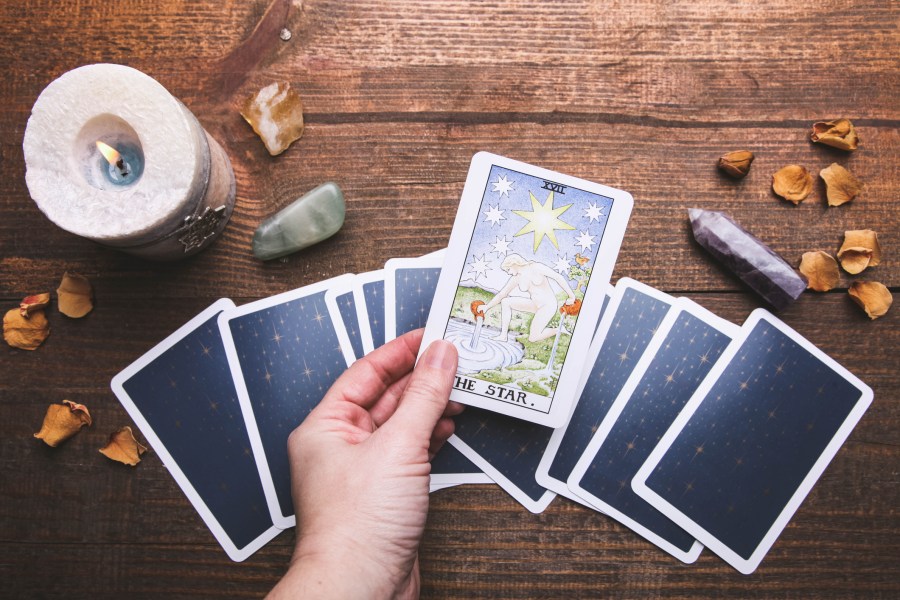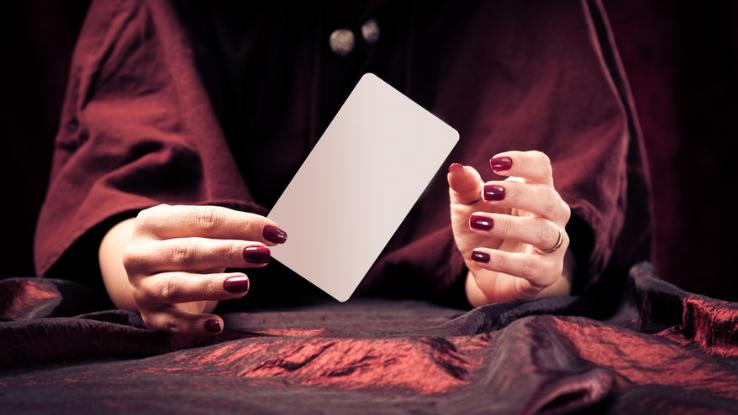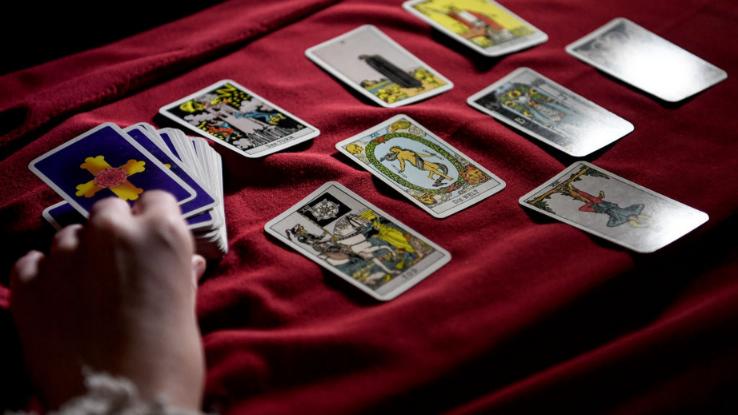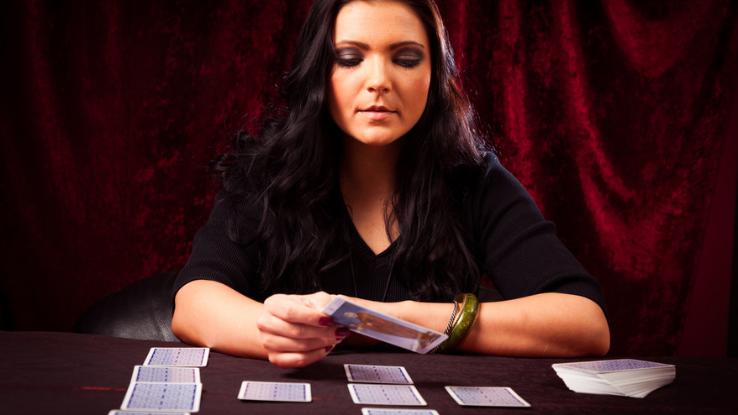How To Pick A Tarot Card

Oftentimes associated with popular activities like burning sage, collecting crystals, and #selfcare, tarot has become a regular staple in many dissimilar cultures and communities today. Even the way make DIOR has gotten in on the tarot conversation, releasing collections inspired by the many images found in a tarot deck.
Simply tarot is more than simply aesthetics. Information technology's like shooting fish in a barrel to get lost in the images of a tarot deck the same way you might become lost in an art museum, but tarot's history goes back centuries and the images were chosen purposefully. People did non always read tarot, just personal tarot readings go back a lot farther than you might guess.
Is tarot based on real people or any other divination practices? Or should you be skeptical most the stories that come from the shuffled cards? If you're going to look at them for meaning or advice, knowing the origin of tarot cards and practices can widen your view on the subject field. Here, we're breaking down tarot, starting from the very beginning.
What Is Tarot?
To sympathize what tarot is, nosotros have to travel back to the Renaissance. The bubonic plague of the Middle Ages influenced the beginning of the Renaissance, and non merely in terms of art. During the epidemic, many people stayed indoors and had a lot of fourth dimension on their hands, not unlike what we experienced in 2020. Only with no streaming services or smartphones, people found low-tech means to accept fun.

Then, tarot cards were a lot like the regular playing cards we know today. Both types of cards have four suits and feature "face up" cards like a king, queen, jack and ace. So, if you want, you tin can play traditional card games similar poker or solitaire with your tarot deck. But the 4 suits can also assist with interpreting the cards. Called the "Minor Arcana," the numbered and face cards that align most with modern-day playing cards are (most oft) sorted into the suits of wands, swords, cups and pentacles. The "Major Arcana" are 22 cards without suits like The Lovers, The Fool and The Devil.
Back then, they didn't phone call the cards "tarot." Instead, they used the give-and-take "trionfi." Trionfi can interpret to "trump card" or "triumph cards." Trionfi decks are historical artifacts. Non many survive today. The actual game that was played with them was called "tarocchi."
Many of the early on decks were based on the images invoked by poets like Francesco Petrarch and Matteo Maria Boiardo. Petrarch was responsible for the term "trionfi" and Boiardo ushered in "tarocchi." The people depicted on the cards were meant to be representations of abstractions, similar justice and love. The illustrations allowed people who didn't get to come across much aside from the country near their homes to experience unique visuals. Knowing that, it's easier to encounter the appeal that tarot had in its early, fun-filled beginnings.
The witchy fun with tarot did non begin until the latter one-half of the 1700s. A lot of the occult clan with tarot came from an essay called "Le Monde Primitif" by Antoine Courtroom de Gébelin. In the essay, Gébelin asserts that tarot came from The Book of Thoth, a collection of writings believed to have been written by Thoth, an ancient Egyptian god. This thought would be labeled fake news now, but back then in that location weren't fact-checkers, so the story persisted.
Inspired by this writing, a fortune teller named Jean-Baptiste Alliete, who used the pseudonym "Etteilla," helped popularize reading tarot cards as opposed to playing with them. Etteilla was fortune-telling prior to this, then he was able to construct and apply the cards to his own practice. In 1789, Etteilla released their first deck along with a guide. (Every bit is the case with many spiritual practices today, capitalism is unfortunately never far abroad.)
Tarot'southward status as an up-and-coming trend created a need for notable tarot bill of fare readers. Marie Anne Lenormand read tarot cards for Napoleon and Josephine Bonaparte, Robespierre, and Tsar Alexander I. "Celebrity psychics" are definitely non new.

The next major development in tarot reading came from Èliphas Lévi. The French author, who was built-in in the early 1800s and lived until 1875, rejected Etteilla's interpretation of tarot but did believe that tarot had roots in ancient Egypt, existing even before Moses. Dogme et Ritual de la Haute Magic, released in two parts in 1854 (Dogme) and 1856 (Ritual), was Lévi's first book of many on the bailiwick of tarot, paving the fashion for new deck interpretations. Lévi, a sometime Catholic priest, wrote more than 20 books about magic Kabbalah, alchemy, and other spiritual practices.
Tarot entered the modern era in 1909 with the release of the Rider-Waite deck. The Rider-Waite deck featured changes suitable for English language-speaking audiences as well as those that felt more than electric current for the time. In the deck, The Lovers, a popular bill of fare, was inverse from an paradigm of a medieval man and woman being blessed by a priest to Adam and Eve, naked in the garden. Names like "The Papess" were changed to "The Priestess." This type of deck is oftentimes recommended for beginners and remains one of the most popular tarot decks in the globe today.
Cocky Care and Stigma: Tarot Readings Today
Reading tarot cards has never been more pop. People are able to read cards for themselves, loved ones, and even strangers on social media. The occult roots are notwithstanding there, but most tarot readers today would say that the cards are more of a device for interpreting life around them rather than making serious predictions.
While tarot may be more popular than ever, in that location is notwithstanding a stigma associated with the practice. In 2021, eBay banned the sale of readings on their site. And even the ACLU has gone to bat for tarot every bit recently as 2019, arguing that outlawing tarot outright would be a violation of commencement amendment rights.

Despite pushback from some authorities, tarot remains popular with young people, especially immature women. Tarot has been used as a therapeutic technique in some instances. Immature people have had to navigate the 2008 financial plummet, several wars, a pandemic, and other uncertain times. That uncertainty combined with more access to teaching and noesis-sharing than ever before means that people are finding tarot and discovering that it can be a swell way of evaluating their lives and looking ahead to what comes next.
Equally for what comes next for tarot, the celestial sky is the limit. Contemporary tarot decks oft put thematic spins on the cards, like Khaneaton's Blackness Ability tarot deck, which features figures from Black history, including Billie Holiday and Martin Luther King Jr. More artists are creating new decks, both for the sake of empowerment and novelty, all the time. Who knows what sorts of meanings you'll cease upwards taking from a tarot card reading, or how tarot cards will be used down the road.
Source: https://www.reference.com/history-geography/get-tarot-reading?utm_content=params%3Ao%3D740005%26ad%3DdirN%26qo%3DserpIndex&ueid=bd0e8c91-bdc4-450a-b499-8f6c9f876ebb

0 Response to "How To Pick A Tarot Card"
Post a Comment